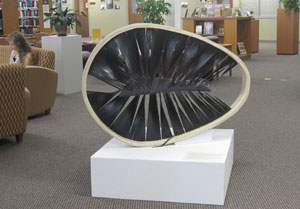 The sculpture in the Study Commons is this year’s Library Art Award winner!
The sculpture in the Study Commons is this year’s Library Art Award winner!
-
Recent Posts
Categories
Archives
Meta
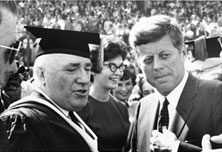 On September 27, 1963 President John F. Kennedy visited Tacoma and gave a speech on education and conservation at a joint convocation held by Presidents R. Franklin Thompson of the University of Puget Sound and Robert Nortvedt of Pacific Lutheran University. Speaking to a crowd of 20,000 that included students, faculty, and politicians, President Kennedy stated, “Those of you now in school must prepare for leadership. You must make sure the United States maintains its responsibilities. We all want to see this country continue to grow.”
On September 27, 1963 President John F. Kennedy visited Tacoma and gave a speech on education and conservation at a joint convocation held by Presidents R. Franklin Thompson of the University of Puget Sound and Robert Nortvedt of Pacific Lutheran University. Speaking to a crowd of 20,000 that included students, faculty, and politicians, President Kennedy stated, “Those of you now in school must prepare for leadership. You must make sure the United States maintains its responsibilities. We all want to see this country continue to grow.”
Among those at the event was The Trail’s editor, who went on to become mayor of 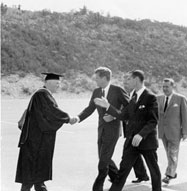 Tacoma, Bill Baarsma. Our Summer Research Fellow interviewed Bill this summer about President Kennedy’s visit and the recording is in the Archives & Special Collections.
Tacoma, Bill Baarsma. Our Summer Research Fellow interviewed Bill this summer about President Kennedy’s visit and the recording is in the Archives & Special Collections.
To see more of President Kennedy’s visit to Tacoma, visit:
The Trail’s coverage of Kennedy in Tacoma
Photographs of Kennedy in A Sound Past
Kennedy’s speech from the JFK Presidential Library and Museum
Press copy of Kennedy’s speech from the JFK Presidential Library and Museum
A story from The News Tribune: The day President Kennedy came to Tacoma
Pacific Lutheran University’s Guide to President Kennedy’s visit
 Amongst our rare book collection is a translated book of short poems written by poet, mathematician, and astronomer Umar Khaiyám in the eleventh century. The poems (four-liners called rubáiyát or quatrains) are very mystical, a quality attributed to Khaiyám’s roots in Sufism, a mystical and somewhat transcendentalist sect of Islam. Sixteen richly colored illustrations in the book depict daily rituals and life in Persia. Alongside the English translation of each poem is a French translation, making this book an interesting read for students studying foreign languages or poetry in the Creative Writing program.
Amongst our rare book collection is a translated book of short poems written by poet, mathematician, and astronomer Umar Khaiyám in the eleventh century. The poems (four-liners called rubáiyát or quatrains) are very mystical, a quality attributed to Khaiyám’s roots in Sufism, a mystical and somewhat transcendentalist sect of Islam. Sixteen richly colored illustrations in the book depict daily rituals and life in Persia. Alongside the English translation of each poem is a French translation, making this book an interesting read for students studying foreign languages or poetry in the Creative Writing program.
Here are a few examples of the style and content of Khaiyám’s poems:
(60)
Every Heart illuminated by the Light of Love, frequenteth the
Shrine of its Illuminator. He, whose Name is written in
Love’s Book, is free from Hope of Heaven, and from Fear of
Hell.
–
Chaque coeur que (Dieu) a éclairé de la lumière de l’affection,
que ce coeur fréquente la mosque ou la synagogue, s’il a
inscrit son nom dans le livre de l’amour il est affranchi et des
soucis de l’enfer et de l’attente du paradis.
(103)
Tell me, o Lover o’ me, what of worldly Riches have I been
able to acquire? None. What of Time past away is left to
me? None. I am Joy’s Torch; but, when its Light is
quenched, I am no more the Torch of Joy. I am Jam’s Cup;
but, being broke, I am no more the Cup of Jam.
–
Dis, ami, qu’ai-je pu acquérir des richesses de ce monde?
Rien. Que m’a laissé dans la main le temps qui s’est écoulé?
Rien. Je suis le flambeau de la joie; mais une fois ce flambeau
éteint, je ne suis plus rien. Je suis la coupe de Djèm, mais
cette coupe une fois brisée, je ne suis plus rien.
To seek out your own interesting archival finds, visit us on Wednesdays from
1:00 – 7:00 p.m. or Thursdays from 9:00 – 11:30 a.m.
By Maya Steinborn
 Looking for digital tools to enhance your research efforts? Bamboo DiRT is a digital humanities initiative that helps you match your needs to specific tools. From creating a mashup to organizing your research, from visualizing data to analyzing texts, Bamboo DiRT will find you the online tools that you need!
Looking for digital tools to enhance your research efforts? Bamboo DiRT is a digital humanities initiative that helps you match your needs to specific tools. From creating a mashup to organizing your research, from visualizing data to analyzing texts, Bamboo DiRT will find you the online tools that you need!
– Contributed by Peggy Burge, Humanities Librarian
PHOTOS: 11 Infamous Book Burnings In History
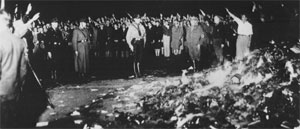 Eighty years ago today, 40,000 people gathered in the Opernplatz in Berlin to witness one of the most famous book burnings in history. Books by authors including Heinrich Mann, Bertolt Brecht and Karl Marx, as well as Ernest Hemingway, Jack London and Thomas Mann were burnt at a Nazi gathering on May 10th 1933 attended by Joseph Goebbels, according to the website of the Holocaust Museum in Washington, D.C. The burning was a coordinated action by the Nazi German Student Association’s Main Office for Press and Propaganda, which they called a “cleansing” (Säuberung). Students marched in torchlit parades through university towns before burning “upwards of 25,000 books” throughout Germany. That night came to symbolize the vile nature of the Nazi regime. In 1995, an underground memorial featuring empty bookshelves visible from above was installed in the square in Berlin where it took place. Rebecca Knuth, author of Burning Books and Leveling Libraries: Extremist Violence and Cultural Destruction, told CBC News in 2010 that book burnings “are highly symbolic. When you destroy a book you are destroying your enemy and your enemy’s beliefs.” That night in Berlin was just one event of a timeline of significant book burnings in history.
Eighty years ago today, 40,000 people gathered in the Opernplatz in Berlin to witness one of the most famous book burnings in history. Books by authors including Heinrich Mann, Bertolt Brecht and Karl Marx, as well as Ernest Hemingway, Jack London and Thomas Mann were burnt at a Nazi gathering on May 10th 1933 attended by Joseph Goebbels, according to the website of the Holocaust Museum in Washington, D.C. The burning was a coordinated action by the Nazi German Student Association’s Main Office for Press and Propaganda, which they called a “cleansing” (Säuberung). Students marched in torchlit parades through university towns before burning “upwards of 25,000 books” throughout Germany. That night came to symbolize the vile nature of the Nazi regime. In 1995, an underground memorial featuring empty bookshelves visible from above was installed in the square in Berlin where it took place. Rebecca Knuth, author of Burning Books and Leveling Libraries: Extremist Violence and Cultural Destruction, told CBC News in 2010 that book burnings “are highly symbolic. When you destroy a book you are destroying your enemy and your enemy’s beliefs.” That night in Berlin was just one event of a timeline of significant book burnings in history.
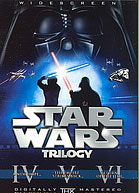 Maybe you’ve seen it, but who doesn’t want to see it again and again! The “Star Wars Trilogy” is here at Collins! Enjoy a Friday movie night with the Dark side.
Maybe you’ve seen it, but who doesn’t want to see it again and again! The “Star Wars Trilogy” is here at Collins! Enjoy a Friday movie night with the Dark side.
Nineteen years after Anakin Skywalker is seduced by the dark side and transforms into the evil Darth Vader, his son Luke Skywalker is thrust into the struggle against the evil Empire. Follow as Luke and twin sister Leia, Han Solo, Chewbacca, Yoda and the droids R2-D2 and C-3PO, lead the Rebellion to bring balance back to the force.
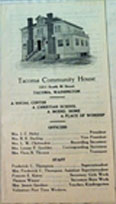 Among the student papers in our Archives & Special Collections is the Sociology I paper of Georgina Rowland, a freshman at the College of Puget Sound in 1932. The document is intriguing because the writer simultaneously expressed prejudice towards non-white people and amenity towards the racially inclusive work done at Tacoma Community House. Georgina wrote on the importance of maintaining the Community House, a local Christian charity, in order to help “the foreigner in an adopted country.” She noted that the most productive work the charity could do was with children, instilling in them a patriotic spirit and “respect for ‘their country.’” In describing how different nationalities of immigrants kept their homes, Georgina inadvertently revealed the racism of her time: “The Negro home represents the future problem in the Community House work,” she noted, going on to remark that miscegenation was an even larger problem in the neighborhood. In the face of a perceived “race problem,” Rowland advocated the Community House as a safe space for immigrants to share their common experiences and improve their lives through English lessons, employment, medical care, library access, and membership in Boy and Girl Scouts Troops. Overall, she determined that “the privileges and good of a Settlement do not come to one race. Exclusion is not known at the Community House.”
Among the student papers in our Archives & Special Collections is the Sociology I paper of Georgina Rowland, a freshman at the College of Puget Sound in 1932. The document is intriguing because the writer simultaneously expressed prejudice towards non-white people and amenity towards the racially inclusive work done at Tacoma Community House. Georgina wrote on the importance of maintaining the Community House, a local Christian charity, in order to help “the foreigner in an adopted country.” She noted that the most productive work the charity could do was with children, instilling in them a patriotic spirit and “respect for ‘their country.’” In describing how different nationalities of immigrants kept their homes, Georgina inadvertently revealed the racism of her time: “The Negro home represents the future problem in the Community House work,” she noted, going on to remark that miscegenation was an even larger problem in the neighborhood. In the face of a perceived “race problem,” Rowland advocated the Community House as a safe space for immigrants to share their common experiences and improve their lives through English lessons, employment, medical care, library access, and membership in Boy and Girl Scouts Troops. Overall, she determined that “the privileges and good of a Settlement do not come to one race. Exclusion is not known at the Community House.”
Despite Georgina’s outdated language, this paper expresses the progressive role that Tacoma Community House had and maintains today providing “services to refugees, immigrants, and English speaking adults and youth.” Georgina’s “The Tacoma Community House: A Social Settlement” also exemplifies how much sociology has changed as a field from the 1930s to today, and would be an interesting read for a current student in the Sociology and Anthropology department.
For more social, historical documents, visit the Archives & Special Collections, which holds slave receipts from the 1830s, a Confederate letter from the Civil War, and civil marriage agreements written in Spanish from the 1770s.
By Maya Steinborn
 This Fall, Return to school day nostalgia by reading 50 of the best campus novels ever! These are books concerning the lives of students, professors, and miscellaneous academics, generally in or around a college.
This Fall, Return to school day nostalgia by reading 50 of the best campus novels ever! These are books concerning the lives of students, professors, and miscellaneous academics, generally in or around a college.
 Trying to save paper and print 2 pages per sheet of paper? In order to print your pages in the correct order using Foxit, follow the steps below to set the correct print parameters. Questions or problems? Ask us – we are here to help.
Trying to save paper and print 2 pages per sheet of paper? In order to print your pages in the correct order using Foxit, follow the steps below to set the correct print parameters. Questions or problems? Ask us – we are here to help.